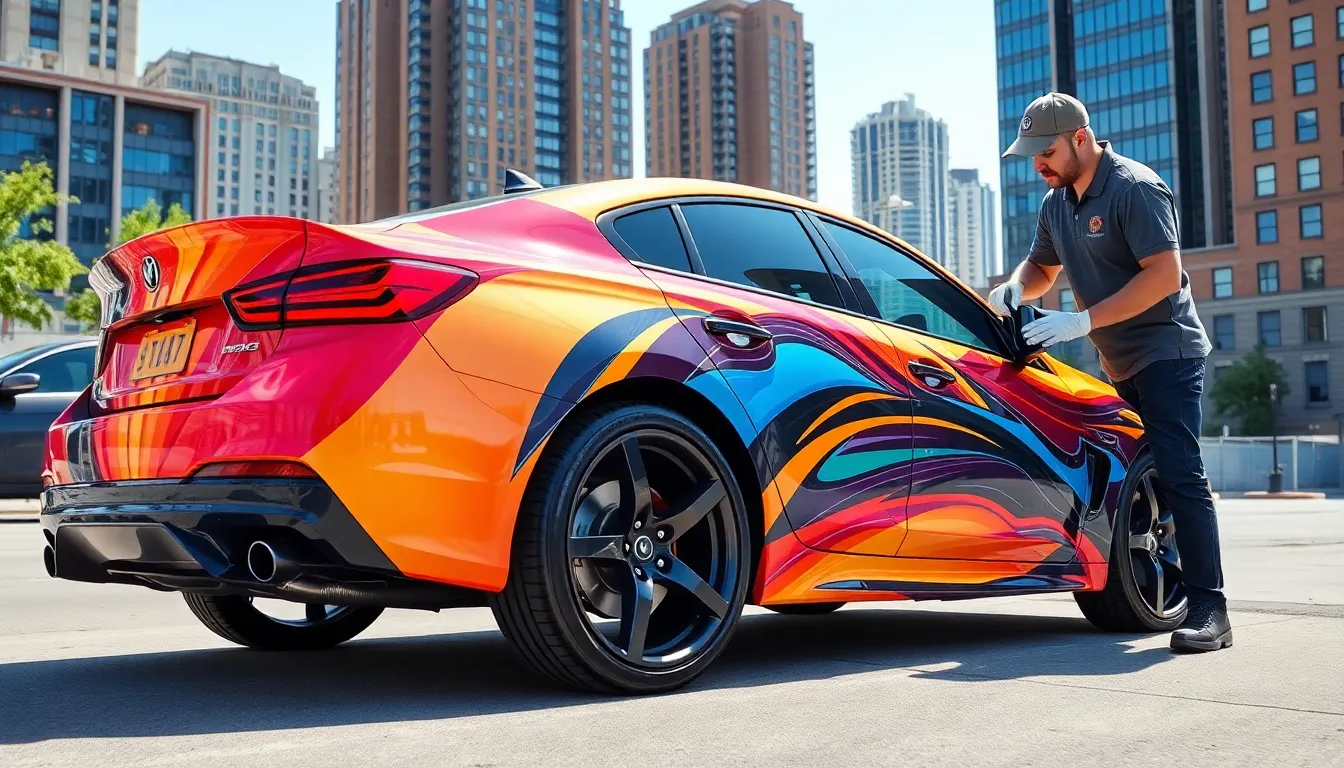We’ve all noticed them cruising down the street – vibrant vehicles that look nothing like their original factory paint job. These eye-catching automobiles aren’t sporting expensive custom paint work. Instead they’re wrapped in vinyl films that transform their appearance completely.
Car wrapping has revolutionized how we think about vehicle customization. Whether it’s a business owner advertising their services or a car enthusiast expressing their personality these vinyl graphics offer endless possibilities. We’re seeing everyone from small businesses to major corporations embrace this cost-effective alternative to traditional paint jobs.
The best part? Wraps protect your car’s original paint while giving you the freedom to change your vehicle’s look whenever inspiration strikes. Unlike permanent paint modifications that can hurt resale value wraps preserve your investment while making a statement that’s uniquely yours.
What Are Wrapped Cars and How Do They Work?
Wrapped cars feature specialized vinyl films applied directly over the original paint surface to create stunning visual transformations. We’ve seen this technology revolutionize how vehicle owners approach customization and branding.
Understanding Vehicle Wrap Technology
Vehicle wrap technology relies on high-performance adhesive vinyl films that conform to every curve and contour of your car’s surface. These films use pressure-activated adhesives that bond securely to painted surfaces while remaining removable without damage. Professional installers use heat guns and specialized tools to stretch the vinyl around complex shapes like bumpers, mirrors, and door handles.
The installation process involves thorough surface preparation to ensure optimal adhesion. Installers clean the vehicle completely and may use primer in certain areas to enhance bonding. Digital printing technology allows for precise color matching and intricate designs that would be impossible with traditional paint methods.
Modern wrap films incorporate air-release channels that prevent bubbles during installation. These microscopic channels allow trapped air to escape naturally, creating smooth, professional finishes. Quality wraps can last 5-7 years with proper care and maintenance.
Types of Wrap Materials Available
Cast vinyl represents the premium choice for vehicle wrapping with superior conformability and durability. Brands like 3M and Avery Dennison produce cast films that stretch easily around complex curves and maintain their appearance for extended periods.
Calendered vinyl offers a budget-friendly alternative for simpler applications and flat surfaces. This material works well for fleet graphics and basic color changes but may not conform as effectively to complex shapes.
Specialty finishes include chrome, carbon fiber, brushed metal, and textured options that create unique visual effects. Matte and satin finishes have gained popularity for their sophisticated appearance and ability to hide minor surface imperfections.
Printed wrap films allow for custom graphics, photographic images, and complex designs using large-format digital printers. These materials combine white or clear vinyl bases with UV-resistant inks that maintain vibrant colors for years.
Architectural films can be repurposed for vehicle applications, offering additional texture and pattern options. But, these materials may not perform as well in automotive environments due to different adhesive formulations.
Benefits of Choosing Wrapped Cars Over Traditional Paint Jobs
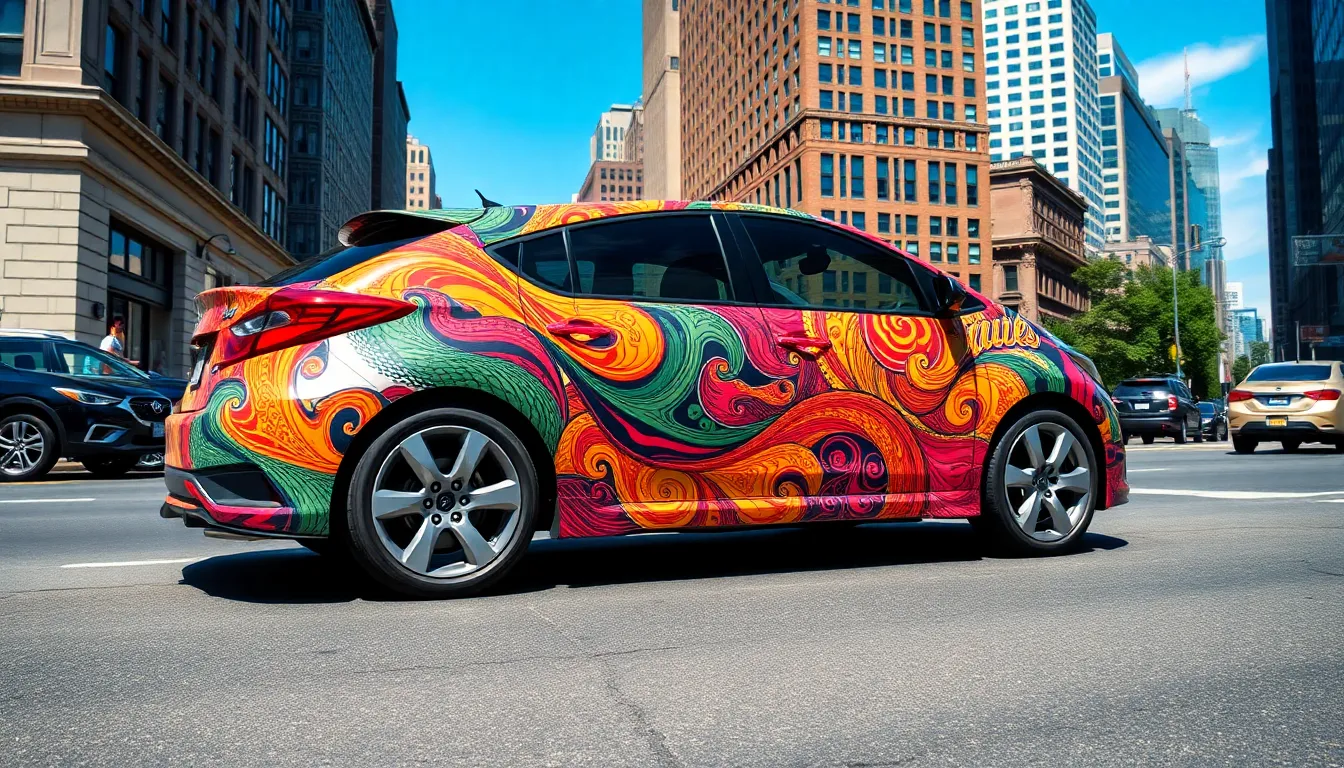
Vehicle wraps offer compelling advantages over traditional paint jobs that make them increasingly attractive to car owners. We’ll explore the key benefits that drive this growing preference.
Cost-Effectiveness and Budget Considerations
Wrapped cars deliver important savings compared to high-quality paint jobs. Professional paint work ranges from $3,000 to $15,000 for premium finishes, while full vehicle wraps typically cost between $2,000 and $5,000. We see even greater value when considering partial wraps, which start around $500 for accent panels.
Installation timeframes favor wraps substantially. Custom paint jobs require 1-2 weeks in the shop, but wrap installation completes in 1-3 days. We appreciate how this reduced downtime keeps vehicles operational for business owners and daily commuters.
Maintenance costs remain lower with wrapped vehicles. Traditional paint requires regular waxing, polishing, and touch-ups that add up over time. Wrapped surfaces need only basic washing and occasional protective treatments, reducing long-term ownership expenses.
Protection for Your Vehicle’s Original Paint
Wrapped cars shield factory paint from environmental damage effectively. The vinyl film acts as a barrier against UV rays, preventing the fading and oxidation that degrades traditional paint finishes. We observe how this protection maintains the original paint’s integrity underneath.
Stone chips and minor scratches affect the wrap instead of permanent paint. Road debris impacts the removable vinyl surface rather than creating costly paint damage. We find this particularly valuable for highway drivers and commercial vehicles facing daily wear.
Resale value preservation becomes a important advantage. Original paint remains pristine beneath wraps, allowing owners to remove the vinyl and reveal factory-fresh surfaces. We’ve seen this protection add thousands to trade-in values compared to vehicles with damaged paint.
Unlimited Design Possibilities and Customization
Wrapped cars enable creative expression impossible with traditional paint. Digital printing technology produces photorealistic images, complex patterns, and gradient effects that would cost tens of thousands in custom paint. We can achieve intricate designs, logos, and artistic elements at fraction of the cost.
Color changes happen easily without permanent commitment. Vehicle owners can experiment with bold colors, finishes, and styles knowing they’re reversible. We observe how this flexibility appeals to enthusiasts who enjoy updating their vehicle’s appearance regularly.
Business branding opportunities expand dramatically with wraps. Companies can display detailed graphics, contact information, and promotional messages across entire vehicle surfaces. We calculate that wrapped commercial vehicles generate 30,000-70,000 daily impressions, making them mobile advertising platforms that traditional paint cannot match.
Popular Types of Car Wraps for Different Styles
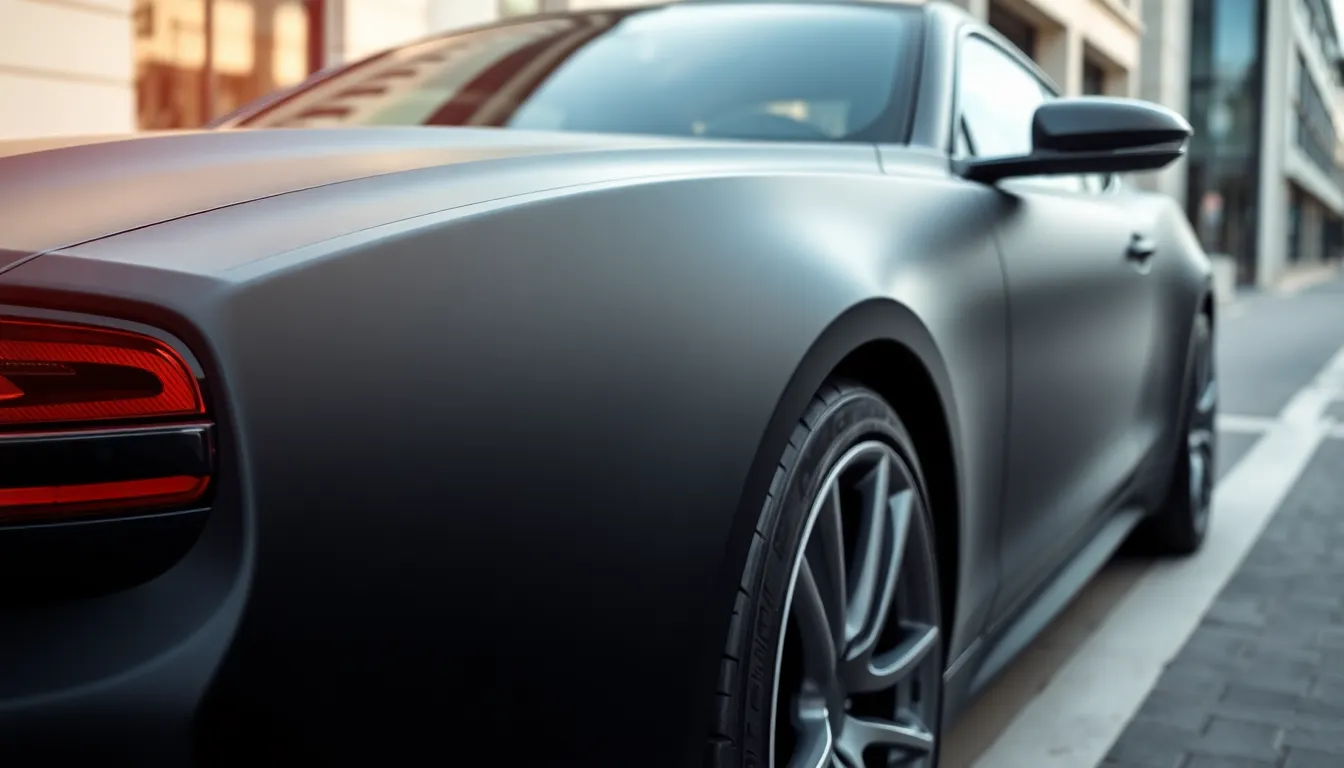
Building on these material foundations, we’ll explore the most sought-after wrap styles that define today’s automotive customization trends.
Matte and Satin Finishes for Modern Appeal
Matte wraps eliminate traditional glossy reflections to create sophisticated, contemporary aesthetics that turn heads on every street. These non-reflective surfaces absorb light rather than bouncing it back, giving vehicles a premium appearance that’s become increasingly popular among luxury car owners and enthusiasts seeking understated elegance.
Satin finishes bridge the gap between matte and gloss, offering subtle sheen that provides depth without overwhelming brightness. We’ve observed these finishes particularly excel on sports cars and modern sedans, where the gentle luster enhances body lines and curves naturally.
Color options in matte and satin categories have expanded dramatically, with popular choices including:
- Deep blacks and charcoal grays for timeless sophistication
- Bold blues and greens for statement-making presence
- Neutral whites and silvers for clean, minimalist looks
- Vibrant reds and oranges for those wanting eye-catching appeal
Maintenance requirements for these finishes differ from traditional gloss wraps, as they require exact cleaning products designed for non-reflective surfaces to prevent streaking and maintain their distinctive appearance.
Gloss Wraps for Classic Shine
Gloss wraps deliver mirror-like reflections that mimic high-end automotive paint finishes while providing all the protective benefits of vinyl film technology. These wraps create stunning visual depth through their ability to reflect light and surrounding environments, making colors appear more vibrant and surfaces more ever-changing.
Traditional appeal drives many vehicle owners toward gloss finishes because they closely replicate factory paint appearances while offering superior customization options. We find these wraps particularly effective on classic car restorations where owners want to preserve authentic aesthetics without compromising the original paint underneath.
Color intensity reaches its peak with gloss wraps, as the reflective surface amplifies pigment saturation and creates rich, deep tones that shift beautifully under different lighting conditions. Popular gloss options include:
| Color Category | Popular Choices | Visual Effect |
|---|---|---|
| Metallic | Silver, gold, copper | Sparkle and shimmer |
| Solid Colors | Red, blue, black, white | Deep saturation |
| Pearl Effects | Pearl white, champagne | Color-shifting properties |
| Candy Colors | Candy apple red, electric blue | Translucent depth |
Professional installation becomes crucial with gloss wraps because any imperfections, scratches, or debris underneath become magnified by the reflective surface, requiring meticulous surface preparation and expert application techniques.
Textured Wraps Including Carbon Fiber and Brushed Metal
Carbon fiber wraps replicate the distinctive weave pattern of actual carbon fiber composite materials, delivering high-tech aesthetics that appeal to performance car enthusiasts and motorsport fans. These wraps feature three-dimensional textures that catch light at multiple angles, creating visual interest that changes as viewers move around the vehicle.
Brushed metal finishes simulate the appearance of machined aluminum, steel, or titanium surfaces through specialized printing and texturing processes that create realistic metallic grain patterns. We’ve seen these wraps gain popularity on trucks, SUVs, and luxury sedans where owners want industrial or aerospace-inspired aesthetics.
Application versatility allows textured wraps to cover entire vehicles or accent exact areas like hoods, roofs, or trim pieces for subtle customization. Strategic placement of these materials can enhance existing body lines or create new visual focal points that transform a vehicle’s overall character.
Texture options continue expanding as manufacturers develop new materials, including:
- Real carbon fiber texture with authentic weave patterns
- Brushed aluminum with directional grain effects
- Diamond plate patterns for rugged, industrial looks
- Wood grain textures for unique, natural aesthetics
- Leather textures for luxury interior-inspired exteriors
Durability considerations vary among textured wraps, with carbon fiber patterns typically offering excellent longevity while some specialty textures may require more careful handling during installation and maintenance to preserve their distinctive surface characteristics.
Commercial Applications of Wrapped Cars in Business
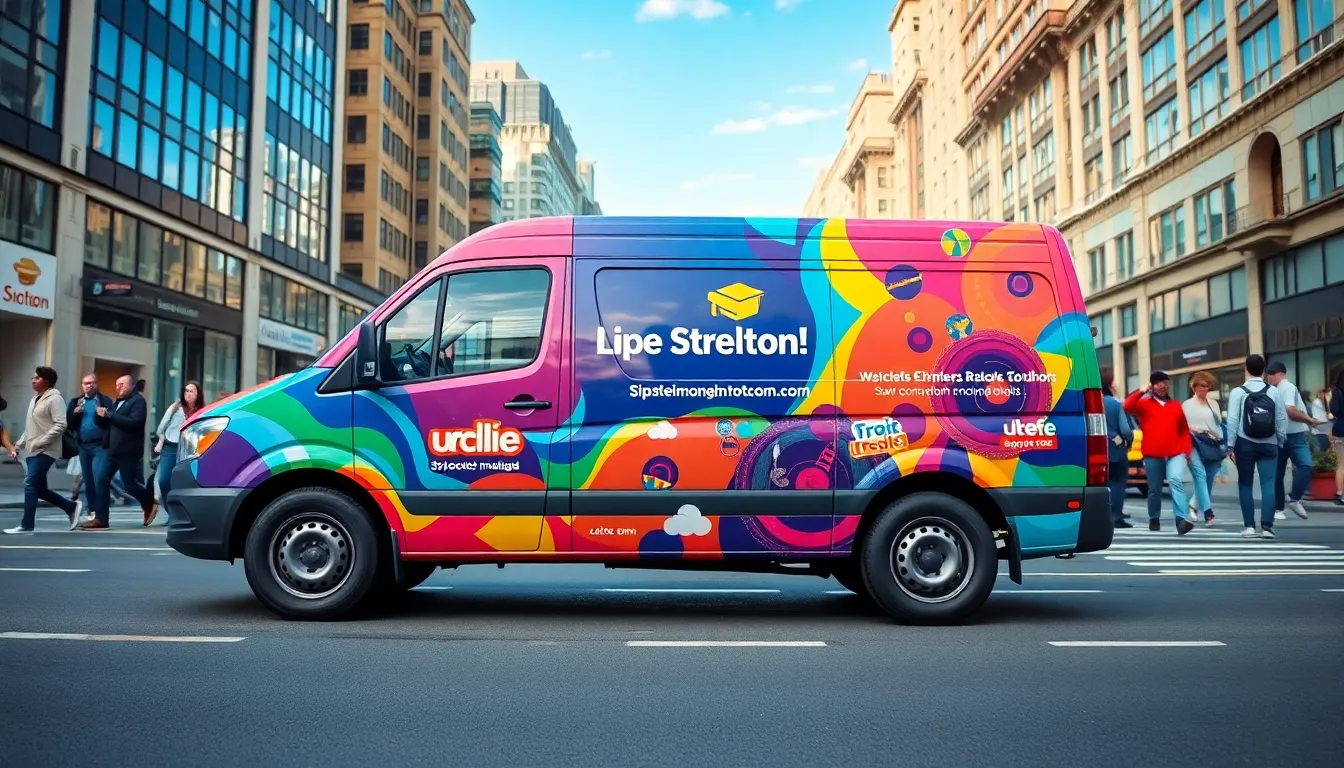
Business owners increasingly recognize wrapped vehicles as powerful marketing tools that deliver measurable results. Companies across industries leverage vehicle wraps to transform their fleets into mobile billboards that generate thousands of daily impressions.
Fleet Branding and Mobile Advertising
Fleet vehicles wrapped with company branding create consistent visual identity across multiple touchpoints. Transportation companies report 30,000 to 70,000 daily impressions per wrapped vehicle, making this advertising method highly cost effective compared to traditional billboard campaigns.
Delivery services transform plain white vans into branded assets using full wrap applications that showcase logos, contact information, and service offerings. Companies like Amazon and FedEx use partial wraps on thousands of vehicles to maximize brand recognition while maintaining budget efficiency.
Construction and plumbing businesses wrap their work trucks to establish credibility and professionalism at job sites. These wrapped commercial vehicles serve as mobile references, displaying completed project photos and customer testimonials that build trust with potential clients.
| Fleet Type | Average Daily Impressions | Cost per Impression |
|---|---|---|
| Delivery Vans | 45,000 | $0.0003 |
| Service Trucks | 30,000 | $0.0004 |
| Company Cars | 25,000 | $0.0005 |
Food Trucks and Service Vehicle Marketing
Food truck operators rely heavily on eye catching wraps to attract customers in competitive markets. Vibrant graphics showcasing menu items and brand personality help food trucks stand out among dozens of competitors at festivals and street locations.
Mobile service businesses use wrapped vehicles to communicate expertise and build customer confidence before arriving at appointments. HVAC technicians, electricians, and pest control companies report increased booking rates when their wrapped service vehicles display professional branding and clear service descriptions.
Ice cream trucks and mobile retail vendors depend on colorful wraps to signal their presence and create excitement among target customers. These wrapped commercial applications often incorporate bold colors, playful fonts, and product imagery that appeals directly to their demographic.
Catering companies showcase their culinary offerings through high resolution food photography printed on their delivery vehicle wraps. This visual marketing approach helps caterers secure more bookings by displaying their menu capabilities directly on their mobile assets.
Corporate Identity and Professional Presentation
Executive transportation services use sophisticated wrapped vehicles to project luxury and reliability to high end clients. Black vehicles with subtle metallic accents and refined typography communicate professionalism while maintaining brand visibility.
Real estate professionals transform their personal vehicles into mobile marketing platforms using wrapped car designs that feature property listings and professional headshots. These mobile advertisements help realtors maintain visibility in their target neighborhoods between appointments.
Medical and dental practices wrap their shuttle vehicles to extend their professional brand beyond office walls. Healthcare providers use clean, medical themed designs that reassure patients about quality and professionalism during transportation services.
Consulting firms and professional service companies use wrapped company cars to reinforce their brand presence at client meetings and industry events. These applications typically feature minimalist designs that communicate competence without appearing overly promotional.
Maintenance Requirements for Wrapped Cars
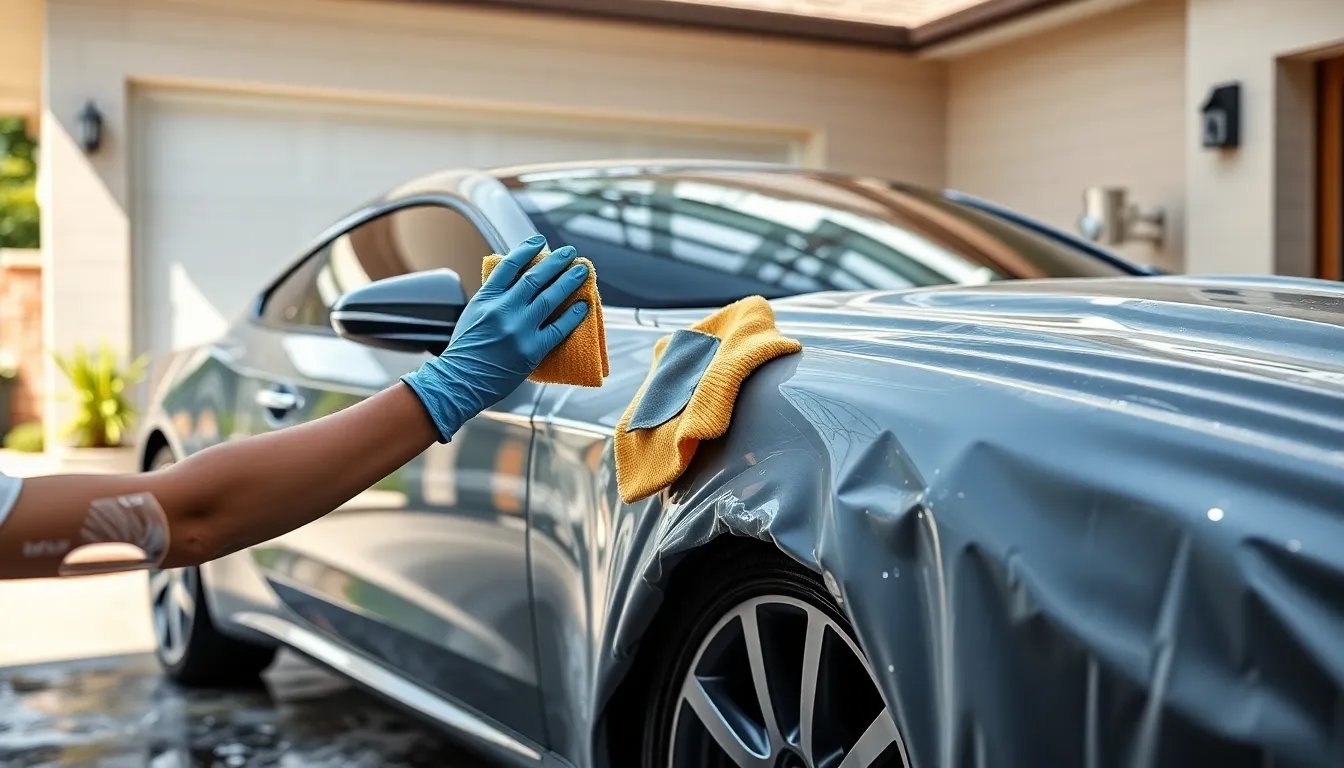
Proper maintenance significantly extends wrap lifespan and preserves the visual impact that makes wrapped vehicles such effective customization tools. We’ll explore essential care techniques that protect your investment and maintain professional appearance.
Proper Washing Techniques and Products
Hand washing delivers the safest cleaning method for wrapped cars. We recommend using pH-neutral automotive soaps like Chemical Guys Mr. Pink or Meguiar’s Gold Class, which won’t damage vinyl adhesives or cause color fading. Temperature matters significantly during washing sessions, so we always use cool or lukewarm water between 40-60°F to prevent wrap lifting.
Microfiber cloths and natural sponges work best for surface cleaning. We avoid abrasive materials like brushes or rough towels that can scratch vinyl surfaces or create micro-tears in the wrap material. Starting from the top and working downward prevents dirt redistribution across clean areas.
Automatic car washes pose serious risks to wrapped vehicles. We never use touchless washes with high-pressure jets above 2,000 PSI, as these can lift wrap edges or force water underneath vinyl layers. Tunnel washes with rotating brushes can catch wrap seams and cause peeling or tearing damage.
Drying techniques require gentle approaches for optimal results. We use clean microfiber towels or chamois to pat surfaces dry rather than dragging materials across the vinyl. Air drying in shaded areas works well, but we avoid leaving water spots that can etch into wrap surfaces over time.
Protecting Against UV Damage and Weather
UV protection extends wrap longevity by 2-3 years in most climates. We apply UV-resistant spray waxes designed for vinyl every 3-4 months, creating protective barriers against sun damage that causes fading and brittleness. Products like 303 Aerospace Protectant offer excellent UV blocking without leaving residue.
Parking strategies significantly impact wrap preservation over time. We seek covered parking whenever possible, as direct sunlight exposure for 8+ hours daily can reduce wrap life by 30-40%. Carports, garages, or even strategic shade positioning help maintain color vibrancy and material flexibility.
Weather protection involves proactive maintenance during harsh conditions. We inspect wrap edges after severe storms, looking for lifting or water intrusion that could lead to adhesive failure. Snow and ice removal requires plastic scrapers rather than metal tools that can gouge vinyl surfaces.
Seasonal maintenance schedules optimize wrap performance year round. We increase washing frequency during winter months when road salt and debris accumulate, potentially causing chemical reactions with wrap adhesives. Spring cleaning sessions remove accumulated contaminants before they permanently bond with vinyl surfaces.
When to Seek Professional Maintenance Services
Edge lifting requires immediate professional attention to prevent complete failure. We contact wrap installers when we notice corners or seams beginning to separate, as DIY repairs often create larger problems. Professional technicians use specialized adhesion promoters and heat application techniques that restore proper bonding.
Color matching becomes necessary when partial wrap replacement occurs. We schedule professional consultations when sections show important fading or damage, ensuring new materials blend seamlessly with existing wrap areas. Digital color matching technology helps maintain consistent appearance across the entire vehicle.
Annual professional inspections identify potential issues before they become costly repairs. We recommend scheduling maintenance checks with certified installers who can assess adhesive integrity, surface preparation quality, and overall wrap condition. These services typically cost $150-300 but can prevent thousands in premature replacement expenses.
Complex repair situations exceed typical DIY capabilities and require expert intervention. We seek professional help for bubble formation, important tears, or adhesive failure affecting large surface areas. Attempting complex repairs without proper tools and experience often results in complete wrap replacement rather than targeted fixes.
Installation Process for Vehicle Wraps
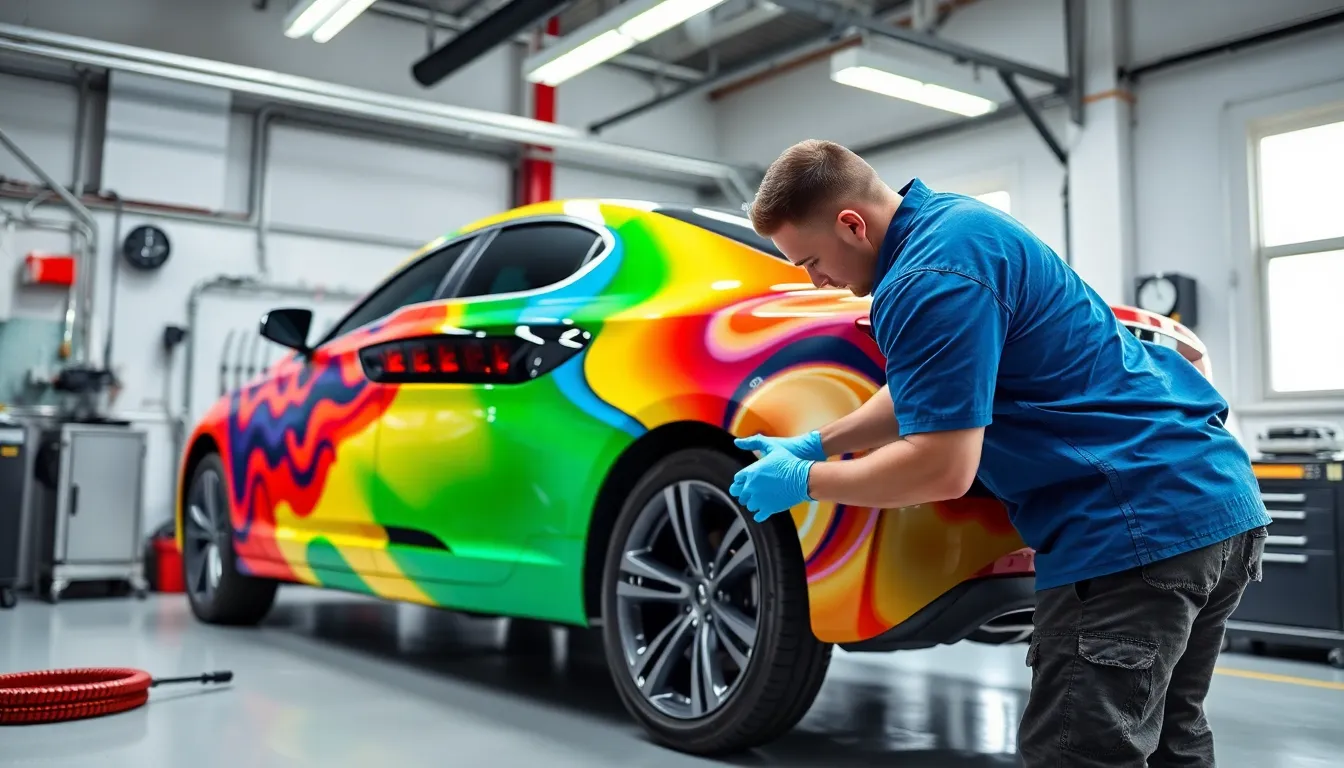
Understanding the installation process helps vehicle owners make informed decisions about their wrap investment. The success of any vehicle wrap depends heavily on proper preparation and skilled application techniques.
Preparation Steps Before Wrapping
Thorough cleaning represents the foundation of successful wrap installation. We recommend washing the vehicle with degreasing agents to remove all dirt, wax, and contaminants that could prevent proper adhesion.
Surface inspection reveals potential problem areas that require attention before wrapping begins. Installers examine the paint for chips, scratches, rust spots, and body damage that might show through the wrap material.
Paint correction becomes necessary when surface imperfections exceed acceptable limits. We fill minor chips and sand down rough spots to create the smooth surface that high-quality wraps demand.
Temperature control ensures optimal installation conditions within the 68-75°F range. Installation facilities maintain consistent temperatures because extreme heat or cold affects vinyl flexibility and adhesive performance.
Panel removal streamlines the wrapping process for complex vehicle areas. We typically remove badges, trim pieces, door handles, and mirrors to achieve seamless coverage and professional-looking results.
Measurement and templating allow installers to cut wrap materials precisely before application begins. This preparation step reduces waste and ensures proper material coverage across all vehicle surfaces.
Professional Installation Versus DIY Options
Professional installation delivers superior results through specialized tools, controlled environments, and years of experience. We observe that professional shops achieve 95% success rates compared to 60% for DIY attempts.
Cost differences between professional and DIY installations range from $2,000-5,000 for professional work versus $500-1,500 for materials-only DIY projects. But, failed DIY attempts often require professional correction, doubling the original investment.
Tool requirements for DIY installation include heat guns, squeegees, cutting tools, and infrared thermometers that cost $300-800. Professional shops invest $10,000-50,000 in specialized equipment like plotters, laminators, and spray booths.
Skill development takes months or years to master proper stretching, heating, and trimming techniques. We’ve seen experienced installers complete complex curves and contours that challenge even determined DIY enthusiasts.
Warranty coverage differs significantly between professional and DIY installations. Professional shops offer 3-7 year warranties on both materials and labor, while DIY projects typically void manufacturer warranties entirely.
Time investment for DIY projects extends to 40-80 hours for full vehicle wraps compared to 8-24 hours for professional installation teams. Learning curves and mistake correction add substantial time to amateur projects.
Timeline and What to Expect During Installation
Design approval typically requires 1-3 business days for custom graphics or color matching consultations. We finalize all design elements, measurements, and material selections before beginning production.
Material production takes 3-7 business days for printed wraps or specialty finishes that require lamination. Standard color wraps using stock materials can begin installation immediately after vehicle preparation.
Day one installation focuses on vehicle preparation, panel removal, and beginning wrap application on flat surfaces. Professional teams complete 40-60% of full vehicle wraps during the first eight-hour session.
Day two completion covers complex areas like bumpers, mirrors, door handles, and intricate body lines that require careful stretching and heating techniques. Most full vehicle wraps finish within two working days.
Quality inspection occurs throughout the installation process, with final checks for bubbles, lifting edges, and proper adhesion. We perform thorough inspections under different lighting conditions to ensure flawless results.
Curing period allows the adhesive to fully bond with the vehicle surface over 24-48 hours after installation. During this time, we recommend avoiding car washes, extreme temperatures, and high-pressure washing.
Final delivery includes care instructions, warranty documentation, and maintenance recommendations to maximize wrap lifespan. Professional installers provide detailed guidance for proper wrap care and cleaning techniques.
Cost Factors That Influence Wrapped Cars Pricing
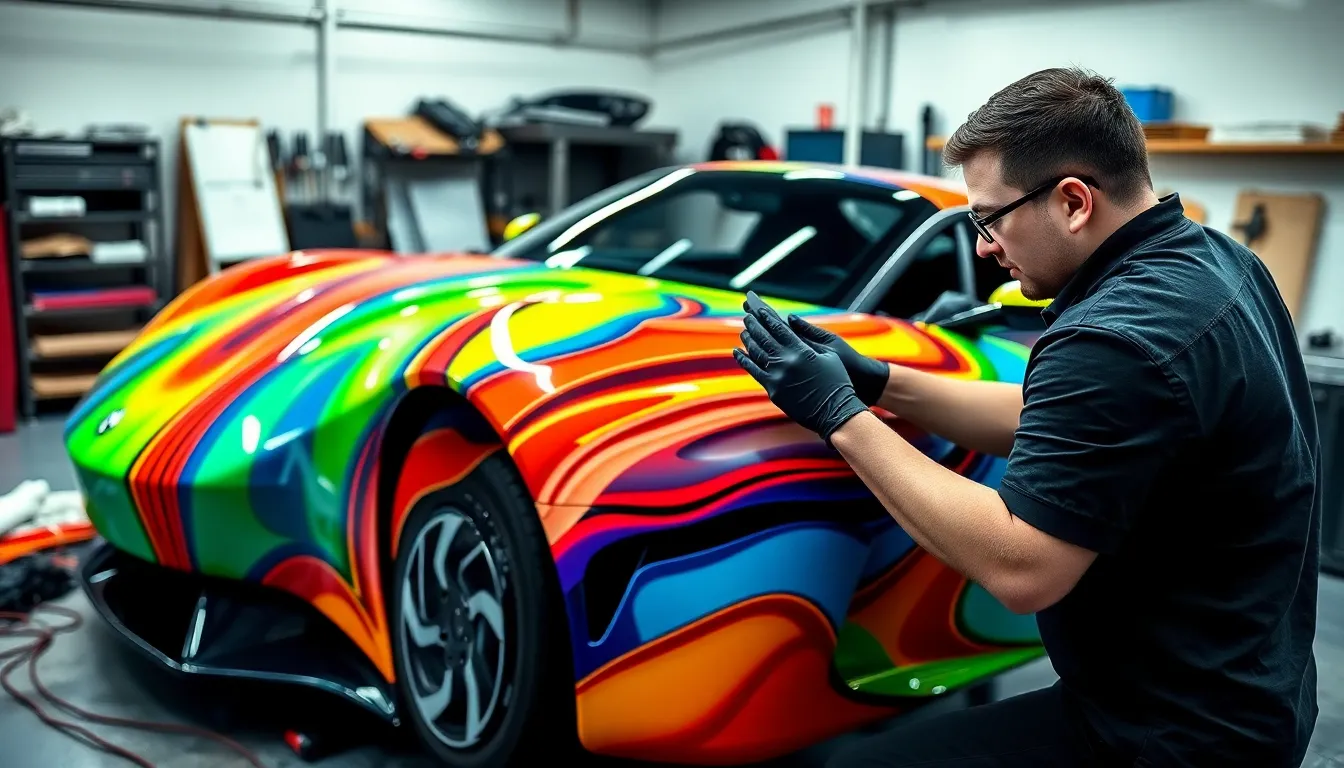
Several key elements determine the final price you’ll pay for your wrapped car project. These factors work together to create pricing ranges that can vary significantly from one installation to another.
Vehicle Size and Complexity Considerations
Larger vehicles require substantially more material and labor time, directly impacting your total investment. Compact cars typically need 50-60 square feet of vinyl, while full-size SUVs and trucks require 75-90 square feet of material coverage.
Curved surfaces and intricate body lines increase installation complexity, requiring skilled technicians to stretch and conform the vinyl properly. Sports cars with aerodynamic curves demand 20-30% more labor time compared to standard sedans with flat panel surfaces.
Door handles, mirrors, and trim pieces add complexity layers that professionals must navigate carefully during the wrapping process. Luxury vehicles often feature chrome accents and detailed bodywork that require precision cutting and tucking techniques.
| Vehicle Type | Material Needed | Average Labor Hours | Complexity Level |
|---|---|---|---|
| Compact Car | 50-60 sq ft | 16-20 hours | Low |
| Mid-size Sedan | 60-70 sq ft | 20-24 hours | Medium |
| Full-size SUV | 75-85 sq ft | 28-35 hours | High |
| Sports Car | 55-65 sq ft | 24-30 hours | Very High |
Material Quality and Design Intricacy
Premium cast vinyl films cost 40-60% more than standard calendered materials, but they offer superior durability and conformability for complex curves. High-end films from manufacturers like 3M and Avery Dennison range from $3-8 per square foot, while economy options cost $1-3 per square foot.
Custom printed graphics and multi-color designs significantly increase material costs due to specialized printing requirements and design development time. Simple color changes using solid vinyl cost substantially less than intricate patterns requiring precise alignment and multiple vinyl layers.
Specialty finishes like chrome, carbon fiber, and textured materials command premium pricing because of their manufacturing complexity and limited availability. Chrome wraps can cost 3-4 times more than standard gloss finishes, while carbon fiber textures typically add 50-70% to material expenses.
Design complexity affects both material waste and installation time, as intricate patterns require careful planning and precise cutting to minimize errors. Multi-panel designs with color transitions need expert color matching and seamless joining techniques.
Geographic Location and Installer Experience
Metropolitan areas typically charge 20-40% higher rates than rural locations due to increased overhead costs and higher demand for professional wrapping services. Cities like Los Angeles and New York command premium pricing compared to smaller markets.
Certified installers with manufacturer training credentials charge higher rates but deliver superior results with comprehensive warranties. Master-level technicians often charge $75-120 per hour, while entry-level installers may charge $40-65 per hour.
Regional competition levels directly influence pricing structures in different markets across the country. Areas with multiple established wrap shops tend to offer more competitive pricing than regions with limited service providers.
Seasonal demand fluctuations affect pricing availability, with spring and summer months typically seeing 15-25% higher rates due to increased customer demand. Winter installations often come with discounted pricing as shops seek to maintain steady workflow during slower periods.
Common Mistakes to Avoid With Wrapped Cars
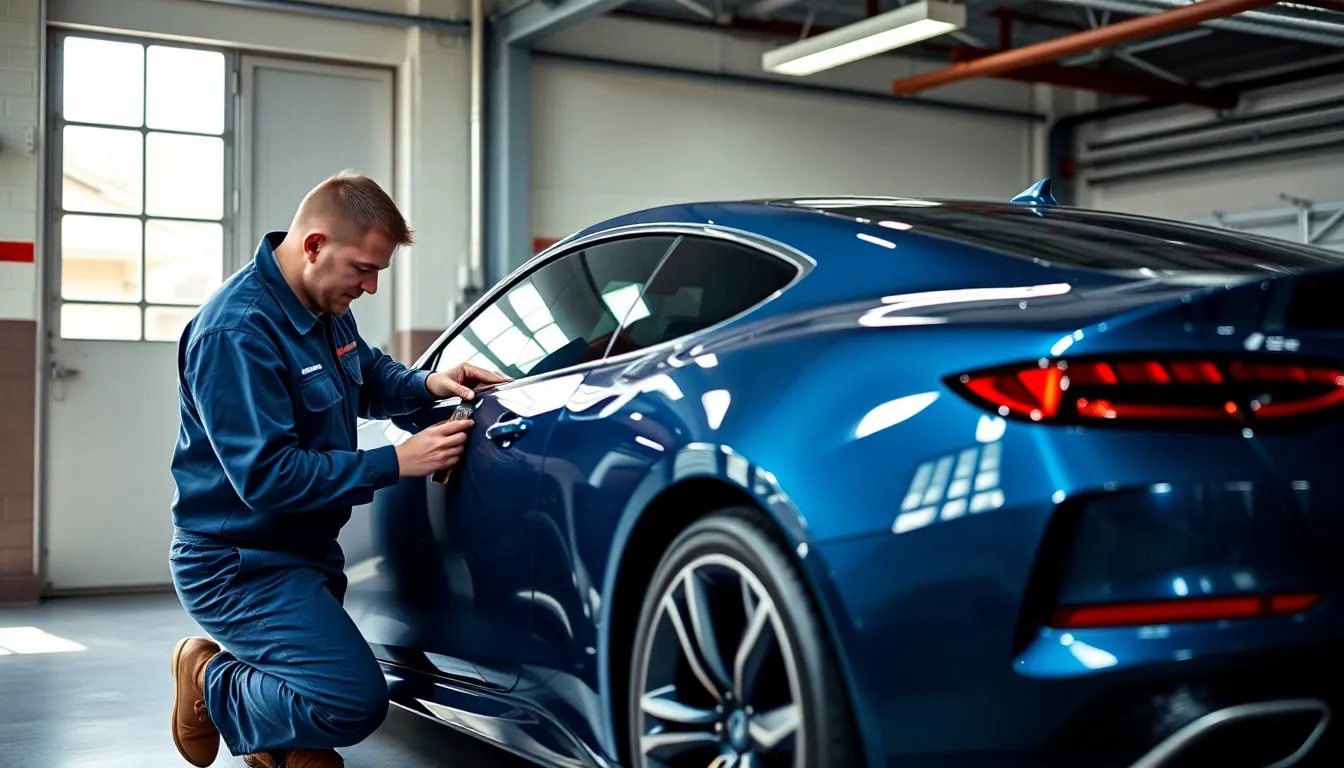
Vehicle owners often make critical errors that can compromise their wrap investment and reduce longevity. Understanding these pitfalls helps ensure optimal results and maximum value from your wrapped car project.
Choosing Low-Quality Materials
Calendered vinyl represents the most frequent material mistake we see in wrapped car installations. Budget-conscious consumers select this option believing they’ll save money, but calendered films shrink significantly within 12-18 months and show visible color fading. Premium cast vinyl costs only 20-30% more upfront yet delivers 3-5 years longer lifespan.
Generic adhesive systems create another costly error that affects wrapped car durability. Inferior adhesives either fail to bond properly or become impossible to remove without damaging paint. Professional-grade 3M and Avery Dennison films use specialized acrylic adhesives that maintain removability for up to 7 years.
Thin gauge materials under 2 mil thickness cannot conform properly to complex curves and body lines. These cheaper options create lifting edges and premature failure, especially around door handles and bumper areas where wrapped cars experience frequent contact.
Improper Surface Preparation
Skipping paint correction before installation creates visible imperfections that telegraph through the vinyl. Small scratches, swirl marks, and oxidation become magnified under wrap films, particularly on gloss and metallic finishes. Professional detailing services charge $200-500 for correction but prevent thousands in rewrap costs.
Inadequate cleaning protocols leave contaminants that prevent proper adhesion in wrapped car applications. Oil residues, wax buildup, and soap film create bonding failures within weeks of installation. Clay bar treatment and isopropyl alcohol wipes ensure pristine surfaces for optimal vinyl adhesion.
Temperature control neglect during installation compromises wrap performance significantly. Applying vinyl below 65°F or above 85°F creates adhesive problems that manifest as edge lifting and bubble formation. Climate-controlled facilities maintain consistent 70-75°F temperatures throughout the installation process.
Surface tension testing gets overlooked by inexperienced installers working on wrapped cars. Dyne pens measure surface energy levels that determine adhesive compatibility. Surfaces below 38 dynes require primer application to achieve proper bonding strength.
Neglecting Regular Maintenance
Automatic car wash damage destroys wrapped car finishes through harsh brushes and high-pressure spray systems. These facilities use recycled water containing abrasive particles that scratch vinyl surfaces. Hand washing with pH-neutral soaps extends wrap life by 2-3 years compared to machine washing.
UV protection oversight accelerates color fading and material degradation in wrapped cars exposed to direct sunlight. Parking in covered areas and applying UV protective sprays every 3-4 months prevents premature aging. Untreated wraps show noticeable fading within 18 months in sunny climates.
Edge lifting ignored allows moisture infiltration that spreads beneath the vinyl surface. Small lifted areas become major problems within weeks if left untreated. Professional re-adhesion costs $50-100 per panel versus complete rewrapping at $2,000-5,000.
Chemical contamination from fuel spills, tree sap, and road salt creates permanent staining on wrapped car surfaces. Immediate cleaning within 24 hours prevents damage, while delayed response often requires panel replacement. Protective wax applications every 6 months create barrier protection against environmental contaminants.
How Long Wrapped Cars Last and Durability Expectations
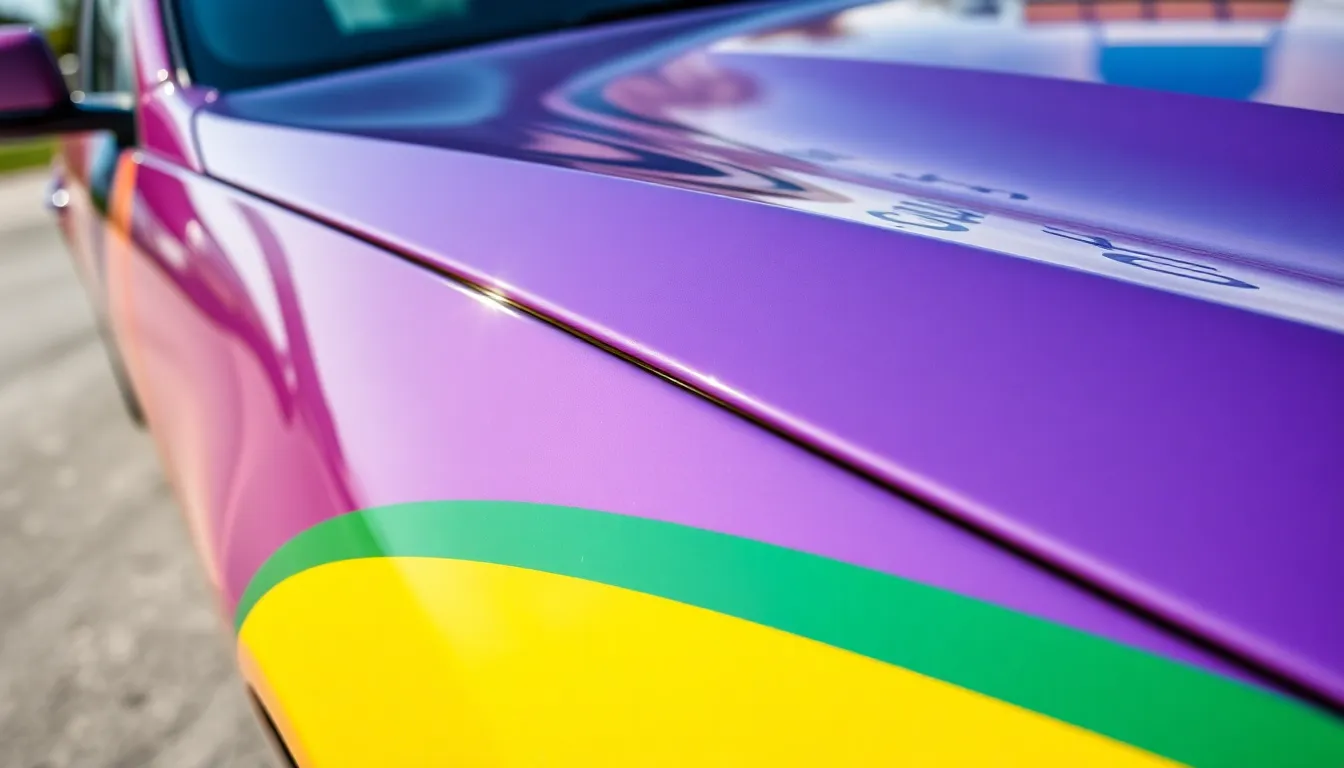
Understanding the lifespan of wrapped cars helps you make informed decisions about your investment. Durability varies significantly based on material quality, installation techniques, and maintenance practices.
Typical Lifespan of Different Wrap Materials
Cast vinyl wraps deliver the longest performance, lasting 7-10 years with proper care and professional installation. 3M’s 1080 series and Avery Dennison’s Supreme Wrapping Film excel in outdoor environments, maintaining color integrity and adhesive strength throughout their lifespan.
Calendered vinyl materials typically last 3-5 years, making them suitable for short-term applications or budget-conscious projects. Oracal 651 and similar products work well for fleet vehicles that undergo regular updates or businesses planning design changes.
Specialty finish wraps vary considerably in durability expectations:
- Chrome wraps last 2-4 years due to their delicate reflective surfaces
- Carbon fiber textured films maintain appearance for 5-7 years
- Matte and satin finishes typically endure 6-8 years with minimal fading
Printed graphics wraps using solvent-based inks generally last 5-7 years, while eco-solvent and latex inks can extend this to 8-10 years when paired with quality laminates.
Factors That Affect Wrap Longevity
Climate conditions significantly impact wrap durability, with extreme temperatures accelerating wear patterns. Arizona’s desert heat reduces lifespan by 20-30%, while moderate climates like California’s coast extend material performance.
UV exposure represents the primary enemy of wrapped cars, causing color fading and adhesive degradation over time. Vehicles parked in direct sunlight experience faster deterioration than garage-stored cars, with southern-facing exposure being particularly harsh.
Installation quality determines how well wraps withstand environmental stresses and daily use. Professional installations with proper surface preparation and edge sealing techniques can double the effective lifespan compared to amateur applications.
Vehicle usage patterns affect wrap longevity through physical stress and contamination exposure:
- Highway driving subjects wraps to constant wind pressure and debris impact
- Urban stop-and-go traffic increases thermal cycling from engine heat
- Off-road adventures expose materials to dust, mud, and branch scratches
Maintenance frequency directly correlates with wrap performance, as regular cleaning prevents contaminant buildup and early degradation. Neglected wraps show edge lifting and adhesive failure 40% sooner than properly maintained ones.
Signs It’s Time for Wrap Replacement
Edge lifting appears as the first visible sign of wrap failure, typically starting at door handles, mirrors, and trim pieces. We recommend addressing minor lifting immediately to prevent moisture intrusion and further damage.
Color fading becomes noticeable after prolonged UV exposure, creating uneven appearance across different vehicle panels. Reds and blues typically fade first, while blacks and whites maintain color integrity longer.
Surface cracking indicates material breakdown from thermal cycling and age, particularly visible on curved surfaces and high-stress areas. Cracked wraps lose their protective properties and should be replaced to prevent paint damage.
Adhesive failure manifests as bubbling, wrinkling, or complete detachment from the vehicle surface. Failed adhesive often leaves residue that requires professional removal and surface restoration.
Permanent staining from road tar, tree sap, or industrial pollutants signals that the wrap can no longer be effectively cleaned. Stained wraps compromise the vehicle’s appearance and may indicate underlying material degradation.
Shrinkage patterns create gaps at panel edges and reveal underlying paint, particularly common with lower-quality calendered vinyls after 2-3 years of service.
Removal Process for Wrapped Cars
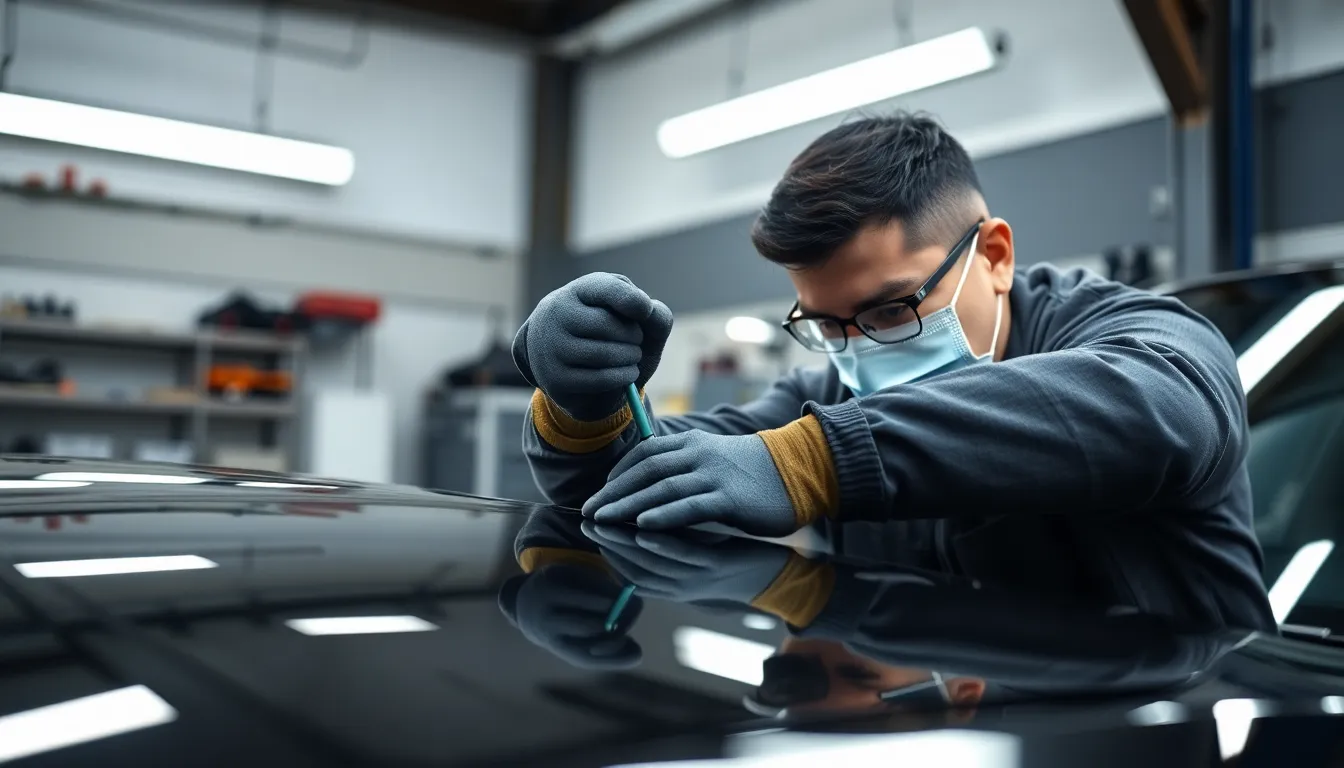
Removing vehicle wraps requires careful planning and proper techniques to avoid damaging the underlying paint. We’ll explore the key factors that determine when removal becomes necessary and the best methods to protect your investment.
When and Why to Remove Vehicle Wraps
Wrap age becomes the primary factor determining removal timing, with most wraps requiring replacement after 5-7 years of service life. Cast vinyl wraps typically maintain their integrity longer than calendered materials, but environmental exposure accelerates deterioration regardless of material quality.
Edge lifting signals immediate attention when wrap corners begin separating from the vehicle surface. Climate conditions contribute significantly to this issue, particularly in areas with extreme temperature fluctuations or high UV exposure levels.
Color fading indicates material breakdown when wraps lose their original vibrancy and develop a chalky appearance. Business owners often remove commercial wraps when rebranding occurs, updating their fleet’s appearance to match new marketing strategies.
Adhesive failure manifests through bubbling or permanent lifting that cannot be corrected through professional repair services. Vehicle owners also initiate removal when selling their cars to restore original paint visibility for better resale value.
Surface cracking develops over time as vinyl materials become brittle from prolonged sun exposure and temperature cycling. We observe this phenomenon most frequently on horizontal surfaces like hoods and roof panels.
Professional Removal Versus DIY Methods
Professional removal services guarantee damage-free results through specialized equipment and proven techniques developed over thousands of installations. Heat guns, steam generators, and chemical adhesive removers allow professionals to work efficiently while minimizing paint exposure risks.
DIY removal attempts often result in paint damage when inexperienced individuals use excessive heat or improper tools during the process. Home removal projects typically require 8-12 hours of labor compared to 2-4 hours for professional services.
Cost considerations favor professionals when factoring potential paint repair expenses from DIY mistakes. Professional removal services charge between $500-$1,500 depending on vehicle size, while DIY attempts risk paint damage costing thousands in bodywork repairs.
Equipment requirements include professional-grade heat sources, plastic razor blades, adhesive removal solvents, and protective materials for surrounding surfaces. Most vehicle owners lack access to commercial steamers that maintain optimal temperature ranges for safe vinyl removal.
Warranty protection covers professional removal services, providing recourse when unexpected paint damage occurs during the process. DIY removal eliminates this protection, leaving owners responsible for any resulting repair costs.
Protecting Your Car’s Paint During Removal
Temperature control prevents paint damage by maintaining wrap material between 80-120°F during removal, ensuring vinyl remains pliable without overheating the underlying surface. Heat application should occur in small sections to avoid thermal shock that can crack paint layers.
Adhesive residue removal requires specialized solvents designed for automotive applications rather than household cleaners that may damage clear coat finishes. Citrus-based removers work effectively on most adhesive types while remaining safe for painted surfaces.
Angle management during pulling keeps removal forces parallel to the paint surface rather than perpendicular, preventing clear coat lifting or paint substrate damage. We recommend 45-degree angles when removing vinyl sections to minimize stress on bonding areas.
Surface preparation after removal includes thorough cleaning with automotive soap followed by clay bar treatment to eliminate remaining contaminants. Paint correction may become necessary if micro-scratches appear during the removal process.
Protection layers should cover adjacent panels and trim pieces to prevent accidental solvent contact or heat exposure during focused removal work. Masking paper and low-tack automotive tape provide adequate protection for surrounding areas.
Post-removal inspection reveals any paint defects that existed before wrap installation, helping owners understand whether issues resulted from removal processes or pre-existing conditions. Professional documentation of paint condition before and after removal protects against false damage claims.
Conclusion
Wrapped cars represent a smart investment for anyone looking to transform their vehicle’s appearance while protecting its underlying value. We’ve seen how this technology offers unparalleled flexibility compared to traditional paint jobs making it an ideal choice for both personal expression and business branding.
The combination of cost-effectiveness durability and reversibility makes vehicle wrapping an increasingly attractive option in today’s automotive industry. Whether you’re seeking a subtle color change or bold custom graphics the wrap industry continues to evolve with new materials and techniques.
By understanding the installation process maintenance requirements and lifespan expectations you’ll be well-equipped to make informed decisions about your vehicle customization project. With proper care and professional installation your wrapped car can deliver years of stunning visual impact while preserving your vehicle’s original finish underneath.
Frequently Asked Questions
What is car wrapping and how does it work?
Car wrapping involves covering a vehicle with specialized vinyl films to change its appearance without painting. The process uses high-performance adhesive vinyl that conforms to the car’s curves and bonds securely to the original paint. Professional installers prepare the surface thoroughly and apply the wrap using precise techniques, ensuring a smooth finish that protects the underlying paint while allowing for complete customization.
How much does it cost to wrap a car?
Full car wraps typically cost between $2,000 and $5,000, significantly less than premium paint jobs which can range from $3,000 to $15,000. The final price depends on vehicle size, material type, design complexity, installer experience, and geographic location. Partial wraps and simpler designs cost less, making wrapping an affordable customization option for most vehicle owners.
How long do car wraps last?
Cast vinyl wraps can last 7-10 years with proper care, while calendered vinyl typically lasts 3-5 years. Specialty finishes vary in durability – chrome wraps last 2-4 years and carbon fiber films last 5-7 years. The lifespan depends on material quality, installation techniques, climate conditions, UV exposure, and maintenance practices. Regular care can significantly extend wrap longevity.
Can car wraps be removed without damaging the paint?
Yes, properly installed car wraps can be removed without damaging the original paint when done correctly. Professional removal services guarantee damage-free results by using proper temperature control and techniques. The wrap actually protects the paint underneath, often revealing pristine factory finish. However, DIY removal attempts can lead to paint damage if not done carefully.
What are the different types of car wrap materials available?
Cast vinyl is the premium choice offering superior durability and conformability. Calendered vinyl is budget-friendly for simpler applications. Popular finishes include matte for sophisticated looks, satin for subtle sheen, gloss for mirror-like reflection, and textured options like carbon fiber and brushed metal. Printed wrap films allow for custom graphics and unlimited design possibilities.
How do I maintain a wrapped car?
Maintain wrapped cars by hand washing with pH-neutral automotive soaps and cool water. Avoid automatic car washes and use gentle drying techniques. Provide UV protection by parking in shade when possible and conduct regular inspections for edge lifting or damage. Professional maintenance services can address issues like color matching and repairs to extend the wrap’s lifespan.
Are wrapped cars good for business advertising?
Wrapped commercial vehicles are highly effective mobile billboards, generating thousands of daily impressions. Delivery vans can achieve up to 45,000 impressions daily, making wraps more cost-effective than traditional billboard advertising. Businesses use wraps to enhance brand recognition, establish credibility, attract customers, and project professionalism across various industries from food trucks to executive transportation services.
What’s the difference between professional and DIY car wrap installation?
Professional installers achieve higher success rates with specialized tools, controlled environments, and warranties. They have experience with surface preparation, temperature control, and complex panel work. DIY attempts often result in bubbles, wrinkles, and additional costs for corrections. While DIY kits are available, professional installation ensures optimal results and protects your investment.
Do car wraps protect the original paint?
Yes, car wraps provide excellent protection against UV rays, stone chips, road debris, and environmental damage. The vinyl acts as a protective barrier, preserving the factory paint underneath. When removed properly, wraps reveal pristine original paint, potentially adding thousands to the vehicle’s resale value. This protection makes wrapping an investment in vehicle preservation.
What are common mistakes to avoid with car wraps?
Avoid using low-quality calendered vinyl that fades and shrinks prematurely. Ensure proper surface preparation with thorough cleaning and paint correction before installation. Don’t attempt installation in improper temperatures or skip professional-grade adhesives. Avoid automatic car washes and address edge lifting promptly. Choose experienced installers and follow proper maintenance practices to maximize wrap longevity and appearance.

